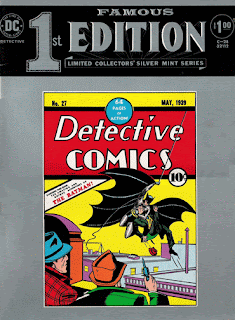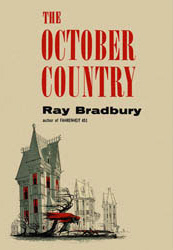by Jack Seabrook
& Peter Enfantino
After a shaky 1973 that found Detective changing to a bi-monthly publication schedule and lower sales across the company, 1974 began with a bold new experiment. Both Batman and Detective Comics, along with many other popular DC titles, expanded to 100 pages per issue with a fifty cent cover price.
The 100-page Super-Spectacular format lasted all through 1974 and into 1975, resulting in only six issues each of Batman and Detective Comics being published with 1974 cover dates. They alternated months, with Detective starting in January and Batman in February. The dates in the indicia were always two months--a February cover date had a January-February date inside.
The fifty cent cover price did not last long--as of the May issue of Detective, the price went up to sixty cents. Julius Schwartz stayed on as editor of Batman while Archie Goodwin continued as editor of Detective. As a result, Batman was aimed at younger readers than Detective. To fill the extra pages, about five reprint stories were featured in each issue, and E. Nelson Bridwell, a fan turned pro, was credited as assistant editor of both series, in charge of selecting reprints.
 All 12 covers were by one or another of four artists: Nick Cardy drew 5 Batman covers while Neal Adams drew one; Adams also drew one cover for Detective, Mike Kaluta drew one, and Jim Aparo drew four. Every issue of both series featured a new Batman lead story, which ran from a short 11 pages to a full-length 20 pages. When the Batman lead story was not 20 pages there was also a new backup story. In Batman, this happened only once, and it featured Robin. In Detective, this occurred five out of six times, and the backup stories featured the serial concerning Manhunter. The sixth issue of Detective, and the only one with a full-length lead story, included a Batman-Manhunter crossover, the only time a new story in the 1974 Detectives included a guest star.
All 12 covers were by one or another of four artists: Nick Cardy drew 5 Batman covers while Neal Adams drew one; Adams also drew one cover for Detective, Mike Kaluta drew one, and Jim Aparo drew four. Every issue of both series featured a new Batman lead story, which ran from a short 11 pages to a full-length 20 pages. When the Batman lead story was not 20 pages there was also a new backup story. In Batman, this happened only once, and it featured Robin. In Detective, this occurred five out of six times, and the backup stories featured the serial concerning Manhunter. The sixth issue of Detective, and the only one with a full-length lead story, included a Batman-Manhunter crossover, the only time a new story in the 1974 Detectives included a guest star.
Batman, on the other hand, was rife with new stories featuring guest stars: Man-Bat, Catwoman, the Penguin, Talia, Two-Face and the Shadow all appeared. The year of 1974 in Batman was when the Rogues' Gallery came back in a big way after having been nearly absent from both books since the beginning of the 1970s.
The new lead stories in Batman were written by Denny O'Neil (4), Frank Robbins (1), and Len Wein (1). The only backup story was written by Elliot Maggin. The new lead stories in Detective were written by Archie Goodwin (5) and Steve Englehart (1). All of the backups were written by Goodwin.
The new Batman lead stories were pencilled by Irv Novick (5) and Neal Adams (1) and all were inked by Dick Giordano. The new Detective lead stories were drawn by six different artists: Jim Aparo, Alex Toth, Vin & Sal Amendola, Sal Amendola alone, Howard Chaykin and Walt Simonson. The Amendola issues were inked by Giordano while the other four artists inked their own pencils. The backup stories in Detective were all drawn by Walt Simonson, while the Batman backup story was pencilled by Dick Dillin and inked by Murphy Anderson.
The reprints, which filled the bulk of the space in these 1200 pages (!), were from the 1940s through the 1960s. All of the reprints in Batman featured Batman and Robin, Robin, or Alfred, while the reprints in Detective featured Batman and Robin (usually one story per issue) and a plethora of other heroes, including the Atom, Hawkman, Green Lantern, Dr. Fate, Elongated Man, Kid Eternity, Manhunter, the Spider, Doll Man, the Newsboy Legion, Plastic Man, Black Canary, Ibis the Invincible, The Spectre, Eclipso, and the Creeper.
Letters columns continued to appear in Batman (Batman's Hot Line) and Detective (Letters to the Batman); there was an additional page in one issue called Rally 'Round Robin. The issues were padded with extras, such as Batman Oddities, The Story of the Batmobile, If Bruce Wayne Had Not Become the Batman, Bat-Puzzle, Bat-Maze, The Catwoman, The Penguin's Unique Umbrella, Casey the Cop, Man Without Fingerprints, A New Look for Robin and Comedy Cover Capers.
 One of the most interesting developments in 1974 was the appearance of new names from fandom in the pages of these professional comics. Fan artist Pat Broderick drew some Table of Contents pages and other short features, while letter writers Martin Pasko and Guy H. Lillian III provided some filler material and edited letters columns.
One of the most interesting developments in 1974 was the appearance of new names from fandom in the pages of these professional comics. Fan artist Pat Broderick drew some Table of Contents pages and other short features, while letter writers Martin Pasko and Guy H. Lillian III provided some filler material and edited letters columns.Batman continued to appear in other DC comics in 1974: he was featured in six issues each of the Justice League of America, World's Finest, and The Brave and the Bold, as well as an issue of Secret Origins. Finally, four $1.00 treasury editions appeared with Batman reprints. They were Limited Collector's Edition C-25, which reprinted five Batman stories, Limited Collector's Edition C-34, which included one Batman reprint, Famous First Edition C-28, which was a facsimile reprint of Detective Comics 27, and Famous First Edition F-5, which was a facsimile reprint of Batman 1.
In short, there were fewer individual Batman and Detective comic books issued in 1974, but the increased page count and the $1.00 books meant that over 1500 pages of Batman comics came out this year, allowing readers and fans to read many old stories that had not been easy to find.
Jack: The end of 1974 marks the halfway point of Batman in the 1970s. I am heartened by the improvement in the comics in 1974 compared to what seemed like a decline in 1973. My favorite period remains 1970-71, when Neal Adams was drawing most or all of the covers and many interior stories. Archie Goodwin's work in 1974 was a landmark, as was the variety of art by such new names as Amendola, Chaykin and Simonson. I'm looking forward to 1975 and the eventual return to normal-length books. I love the 100-pagers but they take a long time to read one after another!
Peter: I hope the quality continues despite the huge loss of Archie Goodwin. I'm cautiously optimistic since we'll see the arrival of Len Wein and Michael Fleisher, writers whose work I've been fond of for years. Obviously, to me, the paucity of the name Frank Robbins is a big plus but the worst aspect of the year was the fumbling of The Rogue's Gallery by writer Denny O'Neil after the phenomenal resurrection of The Joker in Batman 251. As I've commented in past posts, O'Neil may have had his hands tied by editor Julius Schwartz. If not, his "Legendary Writer" status was built on exactly one stellar script.
Jack: Don't forget that he also wrote Green Lantern/Green Arrow, a pretty memorable series.
The Best (and Worst) of 1974
Peter
Best Single Story: Night of the Stalker (Detective 439)
Best Back-Up Story: Resurrection of Paul Kirk (Detective 439)
Best Writer: Archie Goodwin, Manhunter
Best Artist: Walt Simonson, Manhunter
Best Reprint: The House Where Time Stood Still (Detective 442)
Worst Single Story: Catwoman's Circus Caper (Batman 256)
Worst Writer: Denny O'Neil
Worst Art: Irv Novick & Dick Giordano, The Night of the Shadow (Batman 259)
Jack
Best Single Story: Judgment Day (Detective 441)
Best Back-Up Story: Cathedral Perilous (Detective 441)
Best Writer: Archie Goodwin, Batman and Manhunter
Best Artist: Neal Adams, Batman
Best Reprint: Plastic Man (Detective 441)
Worst Single Story: Hail Emperor Penguin (Batman 257)
Worst Writer: Denny O'Neil, Batman
Worst Art: Irv Novick & Dick Giordano, Batman
Peter: I hope the quality continues despite the huge loss of Archie Goodwin. I'm cautiously optimistic since we'll see the arrival of Len Wein and Michael Fleisher, writers whose work I've been fond of for years. Obviously, to me, the paucity of the name Frank Robbins is a big plus but the worst aspect of the year was the fumbling of The Rogue's Gallery by writer Denny O'Neil after the phenomenal resurrection of The Joker in Batman 251. As I've commented in past posts, O'Neil may have had his hands tied by editor Julius Schwartz. If not, his "Legendary Writer" status was built on exactly one stellar script.
Jack: Don't forget that he also wrote Green Lantern/Green Arrow, a pretty memorable series.
The Best (and Worst) of 1974
Peter
Best Single Story: Night of the Stalker (Detective 439)
Best Back-Up Story: Resurrection of Paul Kirk (Detective 439)
Best Writer: Archie Goodwin, Manhunter
Best Artist: Walt Simonson, Manhunter
Best Reprint: The House Where Time Stood Still (Detective 442)
Worst Single Story: Catwoman's Circus Caper (Batman 256)
Worst Writer: Denny O'Neil
Worst Art: Irv Novick & Dick Giordano, The Night of the Shadow (Batman 259)
Jack
Best Single Story: Judgment Day (Detective 441)
Best Back-Up Story: Cathedral Perilous (Detective 441)
Best Writer: Archie Goodwin, Batman and Manhunter
Best Artist: Neal Adams, Batman
Best Reprint: Plastic Man (Detective 441)
Worst Single Story: Hail Emperor Penguin (Batman 257)
Worst Writer: Denny O'Neil, Batman
Worst Art: Irv Novick & Dick Giordano, Batman



















































